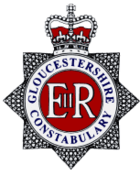Gloucestershire Constabulary
Gloucestershire Constabulary is the territorial police force responsible for policing the non-metropolitan county of Gloucestershire in England (South Gloucestershire is covered by Avon and Somerset Constabulary).
| Gloucestershire Constabulary | |
|---|---|
 | |
| Agency overview | |
| Formed | 1839 |
| Employees | 2,271[1] |
| Volunteers | 143[1] |
| Annual budget | £95.7 million[1] |
| Jurisdictional structure | |
| Operations jurisdiction | Gloucestershire, England |
.svg.png) | |
| Map of police area | |
| Size | 1,025 square miles (2,650 km2) |
| Population | 564,000 |
| Legal jurisdiction | England & Wales |
| Constituting instrument | |
| General nature | |
| Operational structure | |
| Headquarters | Quedgeley |
| Constables | 1,198 (of which 176 are special constables)[2] |
| Police community support officers | 162[1] |
| Police and Crime Commissioner responsible | |
| Agency executive | |
| Local Policing Areas |
|
| Website | |
| www | |
History
The force was founded in 1839, six hours after Wiltshire Constabulary, making it the second rural police force formed in Britain. The force in its present form dates from 1 April 1974, when the southern part of Gloucestershire became part of the County of Avon and thus covered by the newly formed Avon and Somerset Constabulary.
In 1965, the force had an establishment of 1,010 and an actual strength of 867.[3]
From 2013 to 2019, specialist teams – roads, firearms and police dogs – operated in a "tri-force" collaboration with the Avon and Somerset, and Wiltshire forces.[4]
Structure
From April 2011, policing in the county is delivered through six Local Policing Areas: Cheltenham, Gloucester, Forest of Dean, Cotswolds, Stroud and Tewkesbury. Each of these areas is commanded by a superintendent.
Within the six areas there are nine Local Policing Teams covering 55 communities: two each in Cheltenham, Gloucester and Stroud and one in Tewkesbury, the Forest and the Cotswolds.
Chief Constables
- 1839–1865 : Anthony Thomas Lefroy (first Chief Constable of Glos)[5]
- 1865–1910 : Admiral Henry Christian[5]
- 1910–1917 : Lieutenant Colonel Richard Chester-Master (killed in action 1917)
- 1918–1937 : Major F.L. Stanley Clarke[6]
- 1937–1959 : Colonel William Francis Henn[6]
- 1959–1962 : John Gaskain[6]
- 1963–1975 : Edwin White[6]
- 1975–1979 : Brian Weigh[6]
- 1979–1987 : Leonard Soper[6]
- 1987–1993 : Albert Pacey[6]
- 1993–2001 : Anthony J.P. Butler[7][6]
- 2001–2010 : Timothy Brain[6]
- 2010–2012 : Tony Melville[6]
- 2012–2013 : Michael Matthews[6]
- 2013–2017 : Suzette Davenport[6]
- 2017– : Rod Hansen
Officers killed in the line of duty
The Police Roll of Honour Trust lists and commemorates all British police officers killed in the line of duty. The Police Memorial Trust since its establishment in 1984 has erected over 38 memorials to some of those officers.
Since 1817 the following officers of Gloucestershire Constabulary were killed while attempting to prevent or stop a crime in progress:[8]
- Parish Constable Henry Thompson, 1817 (shot by men attempting to free a prisoner)
- Police Sergeant Samuel Beard, 1861 (died from injuries sustained attempting to arrest poachers)
- Police Sergeant William Morris, 1895 (fatally injured by men he warned about their conduct)
Investigations
In 2015, Gloucestershire police were able to show using biomechanical evidence that Robert Nowak was the driver of a car involved in a crash in 2013 in which his friend Michal Sobolak was killed. Nowak was sentenced to 10 years' imprisonment and 7 years' disqualification from driving, for Death by Dangerous Driving, Conspiring to Pervert the Course of Justice and Driving whilst Disqualified.[9][10][11]
Race and sex discrimination in recruitment
In November 2006, a tribunal ruled that the constabulary had illegally discriminated against 108 white male candidates it had rejected from its recruitment process solely because of their race and gender. Matt Powell, one of the "randomly deselected" candidates, took legal action and was awarded £2,500 compensation. The Commission for Racial Equality (CRE) and the Equal Opportunities Commission who led the investigation stated that the Gloucestershire Police had unlawfully discriminated on the grounds of race and gender. The same illegal policy was also used by Avon and Somerset Constabulary.[12][13]
See also
- Gloucestershire Police and Crime Commissioner
- Law enforcement in the United Kingdom
- List of law enforcement agencies in the United Kingdom
- Table of police forces in the United Kingdom
References
- Crime Reduction and Community Safety Group, public enquiries@homeoffice gsi gov uk. "Gloucestershire". webarchive.nationalarchives.gov.uk. Archived from the original on 20 January 2009.
- "Tables for 'Police workforce, England and Wales, 31 March 2013". HM Government. Office for National Statistics. 31 March 2013. Retrieved 29 May 2014.
- The Thin Blue Line, Police Council for Great Britain Staff Side Claim for Undermanning Supplements, 1965
- "Police dogs, firearms and road officers comes back in house after Tri Force disbanded". Wiltshire Times. 10 June 2019. Retrieved 10 June 2019.
- "Early Policing in the Forest of Dean". Deanweb. Retrieved 19 June 2018.
- "Chief Constables". Gloucestershire Police. Retrieved 22 June 2018.
- "Chief Police Officers". Hansard. Retrieved 20 June 2018.
- Police Roll of Honour Trust. "Police Roll of Honour Trust". policememorial.org.uk.
- "Latest Gloucestershire Cheltenham news - Gloucestershire Live". Retrieved 11 September 2016.
- "Man and woman receive prison sentences for fatal road traffic collision in Cheltenham in 2013". Retrieved 11 September 2016.
- Shammas, John (15 May 2015). "Police prove lying driver killed his friend - by using Virtual Reality". Retrieved 11 September 2016.
- "Force admits rejecting white men". BBC News. 22 September 2006. Retrieved 3 April 2011.
- https://www.standard.co.uk/news/police-force-admits-discriminating-against-white-recruits-7244067.html
External links
| Wikimedia Commons has media related to Gloucestershire Constabulary. |